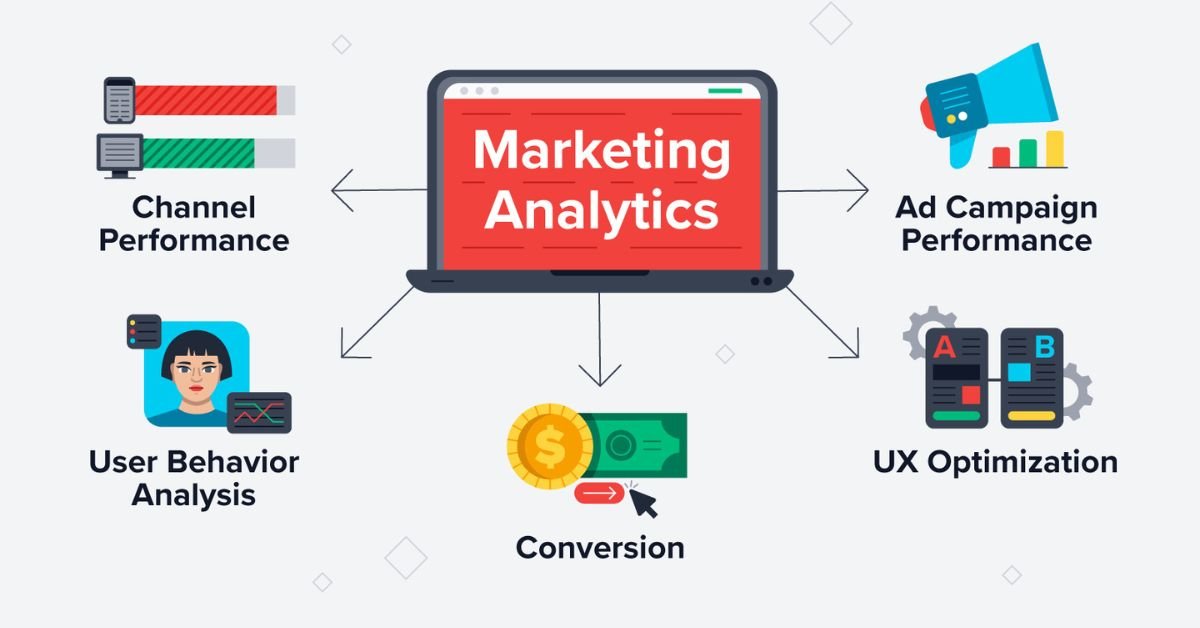In the ever-evolving landscape of digital advertising, Digital Marketing Analytics plays an essential function in shaping methods and assessing success. Recognizing the influence of analytics on your marketing efforts can considerably boost decision-making and drive much better results. This post explores what analytics in digital marketing entails, the types of digital analytics, key metrics that matter, and the role of assessment in crafting effective marketing strategies.

What is Digital Marketing Analytics?
Digital Marketing Analytics and advertising defines the collection, measurement, analysis, and interpretation of information attached to Internet marketing efforts. This information can originate from different resources: sites, social media platforms, e-mail campaigns, and paid promos. By reviewing these details, marketers can get a beneficial understanding of customer habits, project efficiency, and general performance, allowing them to make informed decisions that boost their methods and drive service advancement.
In the electronic age, where customer practices are continually being modified, leveraging analytics makes it possible for online marketers to adapt to these changes rapidly. By understanding how people engage with their material, solutions can improve their approaches to satisfy their target market’s requirements and choices.
What Are the 4 Types of Digital Analytics?
Digital analytics can be categorized right into four primary kinds:
Comprehensive Analytics
Detailed analytics focuses on summarizing historical information to comprehend what has happened in a project. This examination provides insight into trends, patterns, and essential performance. For instance, it can disclose the number of people who visited a website, the length of time they stayed, and which pages were among the most favoured.
Analysis Analytics
This kind of analytics goes further by finding the factors behind previous efficiency. It answers concerns like “Why did our website traffic increase last month?” or “What caused a drop in conversion prices?” Analysis analytics generally requires deeper evaluations, such as A/B testing or examining customer responses.
Predictive Analytics
Preparing for analytics utilizes historical details and statistical algorithms to predict future results. Advertising and marketing specialists can use this information to anticipate client actions and make proactive options. For example, by examining previous acquisition patterns, companies can predict which items will certainly be prominent in the future.
Prescriptive Analytics
Authoritative analytics offers referrals to activities based on information analysis. This kind of analytics can assist advertising and marketing experts optimize their techniques by suggesting the best course of action to achieve desired results. For example, it might mean the suitable time to send out an e-mail job or which audience sector to target for a particular coupon.
What Are 5 Digital Marketing Analytics That Matter?
To correctly identify success, marketing professionals must concentrate on crucial electronic marketing analytics that use considerable understanding. Below are five vital metrics:
Internet site website traffic Sources
Understanding where your internet website traffic comes from is essential for optimizing advertising initiatives. Reviewing internet website traffic resources—such as natural search, paid advertisements, social media sites, and recommendations—helps you recognize which channels are most efficient in driving site visitors.
Conversion Rate
The conversion cost determines the percentage of users who complete a preferred task, such as acquiring or signing up for an e-newsletter. By tracking this data, marketing experts can analyze the effectiveness of their projects and make necessary modifications to enhance efficiency.
Bounce Rate
Jump cost suggests the percentage of website visitors who leave a website after watching only one page. A high bounce price might indicate that the material is not fascinating or appropriate to the target market. Considering bounce costs can help online marketers recognize areas for renovation on their websites.
Consumer Acquisition Cost (CAC).
CAC calculates the complete expenditure of acquiring a new client, having advertising and marketing expenditures. By comprehending CAC, organizations can examine the effectiveness of their marketing and advertising techniques and identify the return on investment (ROI) for their tasks.
Client Lifetime Value (CLV).
CLV estimates that a business’s total profits can leave a solitary customer throughout its relationship. By assessing CLV, advertising specialists can focus on customer retention techniques and structure durable links with essential clients.
What is Analysis in Digital Marketing?
Digital marketing evaluation involves reviewing information to get insights that notify advertising and marketing techniques. This process includes gathering and refining info to boost campaigns and enhance effectiveness. Efficient Digital Marketing Analytics requires a clear understanding of marketing goals and pertinent success metrics. By setting detailed objectives, marketing experts can focus on actionable understandings lined up with company purposes. Thorough analysis allows companies to adapt to changing market problems and consumer habits, an essential skill for staying affordable in today’s busy digital landscape.
Conclusion
The relevance of analytics in electronic advertising and marketing can not be overemphasized. By leveraging Digital Marketing Analytics, businesses can get valuable insights that drive informed decision-making, enhance client experiences, and eventually improve their revenues. As the digital landscape continues to evolve, the ability to analyze and evaluate data will undoubtedly continue to be an essential differentiator for effective advertising and marketing methods. Buying analytics not only aids organizations in understanding their target audience better but also equips them with the devices needed to browse the complexities of digital marketing. As a core marketing strategy, Welcoming Analytics will empower your business to grow in the electronic age.


